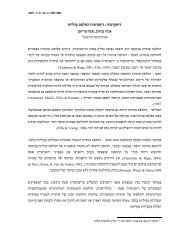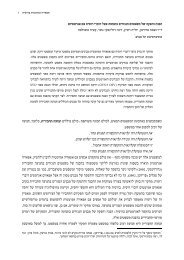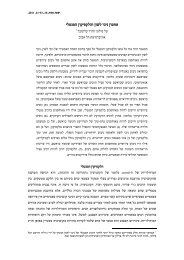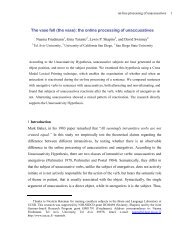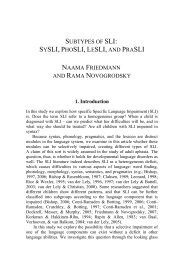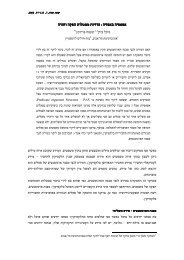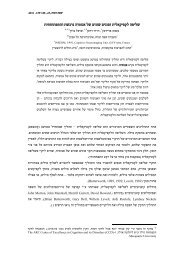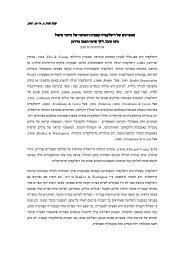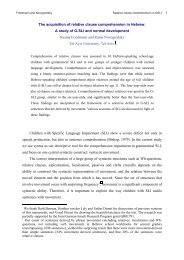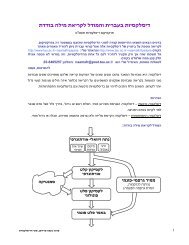Developmental surface dyslexias - Naama Friedmann
Developmental surface dyslexias - Naama Friedmann
Developmental surface dyslexias - Naama Friedmann
You also want an ePaper? Increase the reach of your titles
YUMPU automatically turns print PDFs into web optimized ePapers that Google loves.
cortex 44 (2008) 1146–1160 1147<br />
the current study we focus on developmental <strong>surface</strong> dyslexia<br />
and show that at least three different loci on the lexical<br />
route can be impaired, causing three different subtypes<br />
of developmental <strong>surface</strong> dyslexia, which differ in the patterns<br />
of performance in various tasks.<br />
When the lexical route is unavailable, readers may be<br />
forced to rely on the grapheme-to-phoneme route for oral<br />
reading. Looking more closely into what can cause the lexical<br />
route to be unavailable, several possible loci of impairment<br />
emerge: one might be the orthographic input lexicon<br />
or the access to it ( in Fig. 1). Another possibility is that<br />
the orthographic input lexicon itself is intact and accessible,<br />
but its output is damaged: either its output both to<br />
the phonological output lexicon and to the semantic system<br />
(marked in Fig. 1), or only the output to the phonological<br />
lexicon (marked in Fig. 1), with intact access to the semantic<br />
system.<br />
Grapheme-to-phoneme reading can also result from an<br />
impairment to the semantic system, to the phonological output<br />
lexicon, or its access to the phonemic output buffer (Jackson<br />
and Coltheart, 2001) but in these cases, <strong>surface</strong> dyslexia is<br />
part of a more general language or semantic impairment, and<br />
is not restricted to reading, and we will not explore these subtypes<br />
in the current study.<br />
The three impairments (1–3 in Fig. 1) are expected to<br />
yield a similar pattern of reading aloud. Since all three impairment<br />
loci cause reading via conversion rules, all three<br />
impairments should result in regularizations in reading<br />
aloud. However, importantly, the three impairments are<br />
expected to differ with respect to their effect on lexical decision<br />
and comprehension. The first impairment – involving<br />
lack of access to the orthographic input lexicon, or impaired<br />
orthographic input lexicon 1 – would result both in<br />
difficulty in lexical decision and in impaired comprehension.<br />
Namely, this deficit will result in inability to determine<br />
whether a letter string forms an existing word,<br />
especially when it can be sounded out via grapheme-tophoneme<br />
conversion as an existing word. The comprehension<br />
in this type of impairment will rely solely on the<br />
phonological output of the grapheme-to-phoneme conversion.<br />
Thus, words that are regular and nonhomophonous might<br />
be understood correctly, but irregular words and homophones<br />
would either not be recognized as a word and<br />
thus not be understood, or be recognized as a different<br />
word and misunderstood. For example, if a word like<br />
‘‘yacht’’ would be read as yakt, the reader might say that<br />
she does not recognize the word. A word like ‘‘sale’’,<br />
when identified solely on the basis of the phonological lexicon,<br />
might be defined as ‘‘To move along the sea with<br />
a boat’’, and a word like ‘‘too’’ might be defined as ‘‘The<br />
number after one’’.<br />
Individuals with an impairment of the second subtype –<br />
impaired connection from the orthographic input lexicon to<br />
both the phonological output lexicon and the semantic<br />
1 Ascribing a deficit to the orthographic input lexicon still leaves<br />
the question open whether the deficit is in processes operating in<br />
and on the lexicon, or whether the representations in the lexicon<br />
are impaired (for example, ‘‘faded’’, and require additional activation<br />
to be accessed).<br />
semantics<br />
orthographic-visual analysis:<br />
letter identification letter position letter-word binding<br />
2<br />
orthographic<br />
input lexicon<br />
2<br />
1<br />
3<br />
phonological<br />
output lexicon<br />
phonemic buffer<br />
grapheme-to-phoneme<br />
conversion<br />
Fig. 1 – A model of single word reading. The numbers<br />
indicate possible loci of impairment that lead to<br />
developmental <strong>surface</strong> dyslexia.<br />
system – are expected to be able to decide whether a letter<br />
sequence is a word or not, even when it is a pseudohomophone,<br />
as they have access to the orthographic input lexicon.<br />
Because they do not have access to semantics, they<br />
will fail in comprehension in much the same way as the<br />
first subtype.<br />
Finally, individuals with an impairment of the third subtype<br />
– whose impairment results from a disconnection between<br />
the orthographic input lexicon and the phonological<br />
output lexicon – are expected to perform well both in lexical<br />
decision tasks and in comprehension tasks, when these tasks<br />
do not involve oral reading. This is because they have intact<br />
access to the orthographic input lexicon and from it to the<br />
semantic system. Only when they read aloud will their <strong>surface</strong><br />
dyslexia be manifested, because they will be forced to<br />
use the grapheme-to-phoneme route. 2<br />
Thus, in order to determine the locus of impairment for<br />
each individual with <strong>surface</strong> dyslexia, reading aloud is not<br />
enough. The performance in lexical decision, and specifically<br />
the ability to reject pseudohomophones (nonwords<br />
that can be sounded out like real words, such as fone), would<br />
indicate whether the orthographic input lexicon is accessible.<br />
Comprehension tasks of homophones might speak for<br />
whether or not there is access to the semantic system<br />
from the orthographic input lexicon (Marshall, 1984a).<br />
In a seminal study of acquired <strong>surface</strong> dyslexia, Coltheart<br />
and Funnell (1987) identified seven loci that might<br />
lead to acquired <strong>surface</strong> dyslexia. They showed that their<br />
2 Theoretically, when the pathway between the lexicons is impaired,<br />
one can also use the route from semantics to the phonological<br />
output lexicon in order to read aloud. However, whereas<br />
this route is the natural route for word retrieval, it does not<br />
seem to be a natural route for reading, and this is why the arrow<br />
appears dashed in Fig. 1. It seems to be a last resort, used only<br />
when no other route is available for reading, as is the case in<br />
deep dyslexia. We will return to this point in the Discussion, on<br />
the basis of our results.<br />
1




